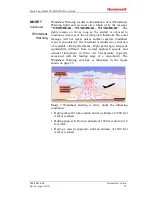
Mark V and Mark VII EGPWS Pilot’s Guide
System Description
060-4241-000
22
Rev H, August 2011
MODE 6
Continued
Bank Angle
Callout
The callout
“BANK ANGLE, BANK ANGLE”
advises of
an excessive roll angle. The EGPWS provides several
excessive bank angle envelopes supporting Air Transport,
Business, or Military aircraft types (only Air Transport and
Business aircraft types are addressed below).
Business
Bank Angle
One envelope is defined for turbo-prop and business jet
aircraft (see graph below). Bank angles in excess of:
•
±10° between 5 and 30 feet,
•
±10 to 40° between 30 and 150 feet,
•
±40 to 55° between 150 and 2450 feet,
•
55° above 2450 feet
produce the bank angle advisory (shaded area). Bank angle
advisories are inhibited below 5 feet.
Summary of Contents for EGPWS MK V
Page 1: ...FILE ONLY Release 08 Aug 2011 14 50 02 MST Printed on 01 Mar 2013 ...
Page 2: ......
Page 4: ......
Page 124: ...Mark V and Mark VII EGPWS Pilot s Guide 060 4241 000 118 Rev H August 2011 ...
Page 125: ......









































